
In physical geography, tundra is a type of biome where the tree growth is hindered by low temperatures and short growing seasons. The term tundra comes through Russian тундра from the Kildin Sámi word тӯндар meaning "uplands", "treeless mountain tract". Tundra vegetation is composed of dwarf shrubs, sedges and grasses, mosses, and lichens. Scattered trees grow in some tundra regions. The ecotone between the tundra and the forest is known as the tree line or timberline. The tundra soil is rich in nitrogen and phosphorus.
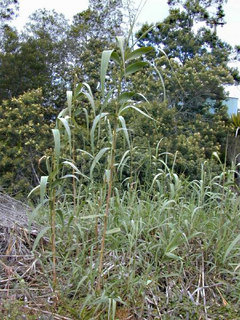
Arundo is a genus of stout, perennial plants in the grass family.

Poa pratensis, commonly known as Kentucky bluegrass, smooth meadow-grass, or common meadow-grass, is a perennial species of grass native to practically all of Europe, North Asia and the mountains of Algeria and Morocco. Although the species is spread over all of the cool, humid parts of the United States, it is not native to North America. The Spanish Empire brought the seeds of Kentucky bluegrass to the New World in mixtures with other grasses. Poa pratensis forms a valuable pasture plant, characteristic of well-drained, fertile soil. It is also used for making lawns in parks and gardens and is common in cool moist climates like the Pacific Northwest, and Northeastern United States. When found on native grasslands in Canada, however, it is considered an unwelcome exotic plant, and is indicative of a disturbed and degraded landscape.

Agrostis is a large and very nearly cosmopolitan genus of plants in the grass family, found in nearly all the countries in the world. It has been bred as a GMO creeping bent grass.

Poa is a genus of about 500 species of grasses, native to the temperate regions of both hemispheres. Common names include meadow-grass, bluegrass, tussock, and speargrass. Poa (πόα) is Greek for "fodder". Poa are members of the subfamily Pooideae of the family Poaceae.

Sirmilik National Park is a national park located in Qikiqtaaluk, Nunavut, Canada, established in 1999. Situated within the Arctic Cordillera, the park is composed of three areas: most of Bylot Island with the exception for a few areas that are Inuit-owned lands, Oliver Sound, and Baffin Island's Borden Peninsula. Much of the park is bordered by water.

Agropyron is a genus of Eurasian plants in the grass family), native to Europe and Asia but widely naturalized in North America.

Eriophorum is a genus of flowering plants in the family Cyperaceae, the sedge family. They are found throughout the arctic, subarctic, and temperate portions of the Northern Hemisphere in acid bog habitats, being particularly abundant in Arctic tundra regions.

Festuca altaica, synonym Festuca scabrella, is a perennial bunchgrass with a wide native distribution in the Arctic, from central Asia to eastern North America. It has been called altai fescue and, under the synonym F. scabrella, rough fescue.
Colpodium is a genus of plants in the grass family, native primarily to Asia but with a few species on certain mountains in Africa.

Glyceria is a widespread genus of grass family common across Eurasia, Australia, North Africa, and the Americas.
Zingeria is a genus of Asian and European plants in the grass family. Their native range covers the Black Sea and eastern Mediterranean regions from Romania to Kazakhstan.
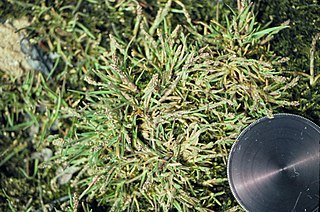
Phippsia is a genus of Arctic and alpine plants in the grass family.
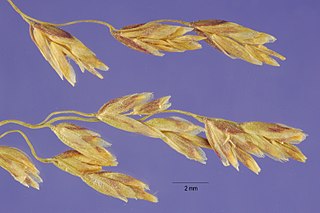
Arctophila is a genus of Arctic and Subarctic plants in the grass family. The only known species is Arctophila fulva, commonly known as pendant grass, native to northern parts of Eurasia and North America.

Arctagrostis is a genus of Arctic and Subarctic plants in the grass family, native to colder parts of Europe, Asia, and North America.
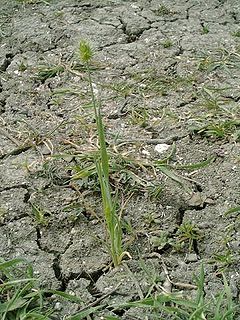
Echinaria is a genus of Eurasian and North African plants in the grass family. The only known species is Echinaria capitata, native to the Mediterranean Region as well as the Southwest and Central Asia.
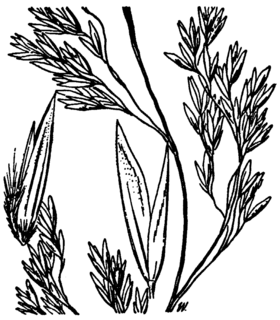
Graphephorum is a genus of North American plants in the grass family.
Pucciphippsia is a genus of Arctic plants in the grass family, reported from Greenland, Svalbard, and Magadan.
Festuca edlundiae, commonly known as Edlund's fescue, is a native, perennial tufted grass found in Alaska, Canadian arctic islands, northern Greenland, far eastern arctic Russia and Svalbard. The specific name honours Doctor Sylvia Edlund, a Canadian botanist. It was first described by Susan Aiken, Laurie Consaul and Leonard Lefkovitch in 1995.















